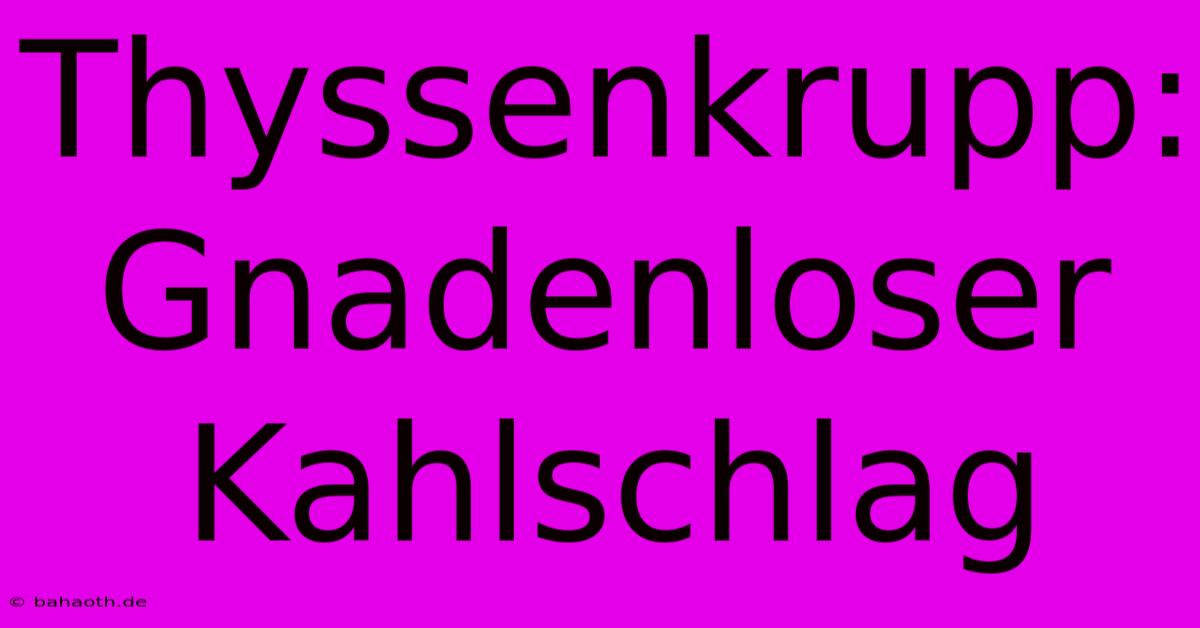Thyssenkrupp: Gnadenloser Kahlschlag

Discover more detailed and exciting information on our website. Click the link below to start your adventure: Visit Best Website Thyssenkrupp: Gnadenloser Kahlschlag. Don't miss out!
Table of Contents
Thyssenkrupp: Gnadenloser Kahlschlag – Ein Überlebenskampf?
Man, oh man. When I first heard about the massive restructuring at Thyssenkrupp, I'll admit, I felt a little… queasy. It’s not just some small company; it’s a giant, a historical player in German industry. The sheer scale of the "Gnadenloser Kahlschlag," as they're calling it – the merciless downsizing – is breathtaking, and frankly, a little terrifying. It makes you wonder, is this just a brutal cost-cutting exercise, or a genuine fight for survival in a rapidly changing global market?
My Initial Reaction (and a Little Panic)
I remember reading the initial news reports – the headlines screamed about job losses, plant closures, and a complete overhaul of the company structure. My gut reaction? Total panic. I've been following Thyssenkrupp's trajectory for years, and to see such drastic measures announced felt like watching a slow-motion train wreck. For a second, I envisioned a complete collapse. This was one of Germany's industrial behemoths, right? How could this be happening?
Understanding the "Why" – A Deeper Dive into the Situation
The thing is, you can't just look at the headlines and scream "bloody murder." You need to understand the why. Thyssenkrupp's been struggling for a while now. The steel industry is brutal, with intense global competition and fluctuating commodity prices. Add in the rising costs of energy and raw materials, and you've got a recipe for disaster. They needed to make some serious changes, or they were going to be facing a much worse fate. This Kahlschlag, as harsh as it is, might just be their only chance for long-term survival.
The Human Cost – Beyond the Numbers
But here's the kicker: behind the numbers – the billions in losses, the percentage points of market share – are real people. Families who rely on those jobs, communities that depend on the factories. It's easy to get lost in the financial details, but we can't forget the human cost of this restructuring. It's a tragedy, no doubt about it.
What This Means for the Future – My Predictions (and Hopes)
So, where do we go from here? It’s hard to say for sure. My gut feeling is that Thyssenkrupp is going to emerge from this leaner, more focused, and possibly more competitive. But that doesn't mean it'll be easy. They'll need to execute their plans flawlessly, manage the transition carefully, and above all, support the employees affected by this restructuring.
I think they should focus on a few key areas: digitalization of their processes for greater efficiency, exploring new sustainable materials and technologies to cater to evolving market demands, and strategic partnerships to share resources and expertise.
Actionable Steps for Businesses Facing Similar Challenges:
- Honest self-assessment: Brutal honesty about the company's weaknesses and strengths is crucial. Don't sweep problems under the rug.
- Long-term vision: Develop a clear, long-term strategy that addresses the root causes of the problems. Short-term fixes won't solve everything.
- Employee communication: Transparent communication with employees throughout the restructuring process is paramount. This builds trust and helps everyone understand the changes.
The Thyssenkrupp situation is a harsh lesson in the realities of the global market. It's a reminder that even the giants can fall if they don't adapt and innovate. Let's hope that, in the end, this Gnadenloser Kahlschlag will be the catalyst for a stronger, more resilient Thyssenkrupp. But we should also remember and learn from the human cost of such drastic measures.

Thank you for visiting our website wich cover about Thyssenkrupp: Gnadenloser Kahlschlag. We hope the information provided has been useful to you. Feel free to contact us if you have any questions or need further assistance. See you next time and dont miss to bookmark.
Featured Posts
-
Leipzig Scheitert In Mailand 1 0
Nov 27, 2024
-
Spielbericht Inter Leipzig Champions League 26 10
Nov 27, 2024
-
Alte Pinakothek Rachel Ruysch Blumen
Nov 27, 2024
-
Volkswagen Aktie Hoffnung Keimt Auf
Nov 27, 2024
-
Swissquote Aktie Faellt Am Montag
Nov 27, 2024
